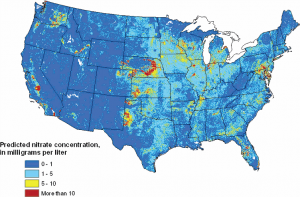9.3 Groundwater Pollution
Solute transport is one of the primary mechanisms causing groundwater pollution around the world. One common groundwater contaminant of concern is nitrate, NO3–, which can be readily leached from agricultural soils receiving nitrogen inputs through fertilizers or manure. In the US, observations of nitrate concentrations in groundwater have been used to develop statistical models that can estimate groundwater nitrate concentrations across the nation [4]. The US Environmental Protection Agency (EPA) has set a “maximum contaminant level” on nitrate in drinking water at 10 mg L-1. Model predictions (and in many cases, actual measurements) show that this level has been exceeded for many locations in the US, particularly in portions of the Great Plains, the upper Midwest, the East Coast, and California’s Central Valley (Fig. 9‑6). These high nitrate concentrations are associated with relatively high nitrogen application rates, high water inputs (rain plus irrigation), and well-drained or coarse-textured soils.

Agriculture is not the only human activity which has contributed to groundwater pollution. Serious groundwater pollution has also occurred from mining, oil and gas production, industrial activities, and leaking underground storage tanks at gas stations like the ones many of us use on a regular basis. These types of contamination sometimes necessitate costly remediation efforts. Hydrocarbons such as benzene and toluene and chlorinated solvents like trichloroethylene (TCE) and tetrachloroethylene (PCE) are examples of serious groundwater contaminants arising from these types of human activities. In recent years, there has been growing concern about the process of hydraulic fracturing or “fracking” used in oil and gas production and its potential threat to groundwater resources. The US EPA has thus far not found widespread evidence of groundwater pollution due to “fracking”, although some isolated cases have been reported. The available evidence indicates that accidental spillage of fracking fluid or produced water on the land surface constitutes a greater risk to groundwater than the associated below-ground activities. This fact reinforces the importance of understanding the mechanisms of solute transport in the soil.

